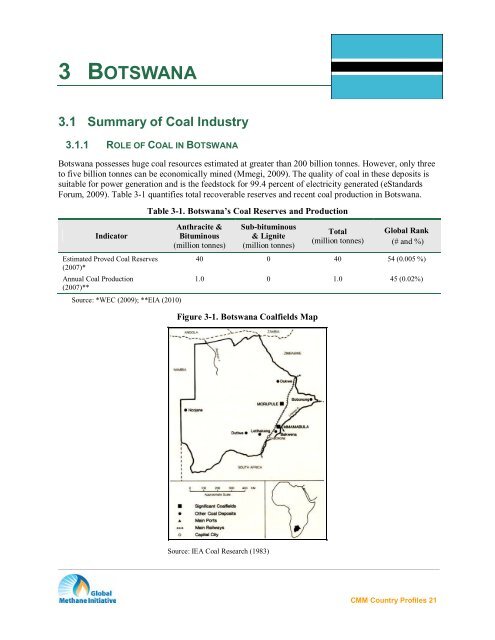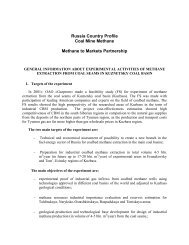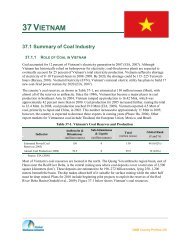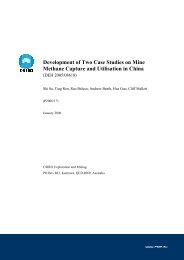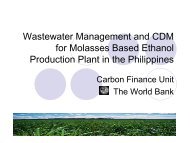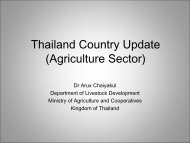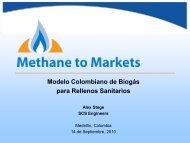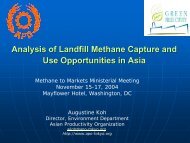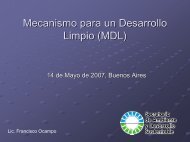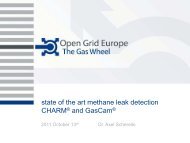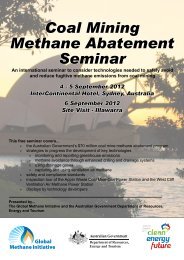Coal Mine Methane Country Profiles - Global Methane Initiative
Coal Mine Methane Country Profiles - Global Methane Initiative
Coal Mine Methane Country Profiles - Global Methane Initiative
Create successful ePaper yourself
Turn your PDF publications into a flip-book with our unique Google optimized e-Paper software.
3 BOTSWANA<br />
3.1 Summary of <strong>Coal</strong> Industry<br />
3.1.1 ROLE OF COAL IN BOTSWANA<br />
Botswana possesses huge coal resources estimated at greater than 200 billion tonnes. However, only three<br />
to five billion tonnes can be economically mined (Mmegi, 2009). The quality of coal in these deposits is<br />
suitable for power generation and is the feedstock for 99.4 percent of electricity generated (eStandards<br />
Forum, 2009). Table 3-1 quantifies total recoverable reserves and recent coal production in Botswana.<br />
Indicator<br />
Estimated Proved <strong>Coal</strong> Reserves<br />
(2007)*<br />
Annual <strong>Coal</strong> Production<br />
(2007)**<br />
Source: *WEC (2009); **EIA (2010)<br />
Table 3-1. Botswana’s <strong>Coal</strong> Reserves and Production<br />
Anthracite &<br />
Bituminous<br />
(million tonnes)<br />
Sub-bituminous<br />
& Lignite<br />
(million tonnes)<br />
Total<br />
(million tonnes)<br />
<strong>Global</strong> Rank<br />
(# and %)<br />
40 0 40 54 (0.005 %)<br />
1.0 0 1.0 45 (0.02%)<br />
Figure 3-1. Botswana <strong>Coal</strong>fields Map<br />
Source: IEA <strong>Coal</strong> Research (1983)<br />
CMM <strong>Country</strong> <strong>Profiles</strong> 21
BOTSWANA<br />
In 2007, coal represented 36.2 percent of Botswana’s total primary energy supply (IEA, 2009). At<br />
present, all coal mined is used domestically for power production, but studies are under way to explore<br />
the possible exportation of coal mined at the Morupule mine, the country’s only operating mine (Mining<br />
Journal, 2005).<br />
The Morupule <strong>Mine</strong> is located in the Morupule coalfield near the town of Serowe (Figure 3-1) and is the<br />
most thoroughly explored of Botswana’s fields. The only other major coal field to be explored in some<br />
detail is Mmamabula, situated about 81 miles south of Morupule (IEA, 2010).<br />
3.1.2 STAKEHOLDERS<br />
Table 3-2 identifies potential key stakeholders in Botswana’s coal mine methane (CMM) and coalbed<br />
methane (CBM) development.<br />
Table 3-2. Key Stakeholders in Botswana’s CMM Industry<br />
Stakeholder Category Stakeholder Role<br />
Developers<br />
Engineering, Consultancy and<br />
Related Services<br />
Government and Research<br />
Organizations<br />
• Kalahari Energy<br />
• TLOU<br />
• Anglo <strong>Coal</strong> Botswana<br />
• SAFGAS<br />
• Many other small developers<br />
• See http://www.epa.gov/coalbed/networkcontacts.html<br />
• Scales & Associates<br />
• Advanced Resources International (ARI)<br />
• See http://www.epa.gov/coalbed/networkcontacts.html<br />
• Botswana Ministry of <strong>Mine</strong>rals, Energy, and Water<br />
Affairs<br />
• Botswana Geologic Survey<br />
• Botswana Power Corporation<br />
• Botswana Gas Corporation.<br />
3.1.3 STATUS OF COAL AND THE COAL MINING INDUSTRY<br />
Project opportunity<br />
Technical assistance<br />
Regulatory<br />
There is only one operating coal mine in Botswana, the Morupule <strong>Mine</strong>, which is 93 percent owned by<br />
Debswana (a joint venture of DeBeers and the Government of Botswana) and supplies coal to Botswana’s<br />
only coal-fired power station. Production from the mine is relatively stable (0.8–1 million tonnes [Mmt]<br />
per year) as it is essentially a captive mine for the Morupule Power Station. The mine also supplies coal to<br />
hard rock mining operations at Selebi-Phikwe and to the Sua Pan soda ash plant, and coal is exported to<br />
Zimbabwe, Zambia and the Democratic Republic of the Congo.<br />
Debswana announced plans to increase coal production at the Morupule <strong>Mine</strong> to 3.4 Mmt a year to<br />
accommodate Botswana Power Corporation’s (BPC) plans to add four 150-megawatts (MW) coal-fired<br />
power stations alongside the existing four 33-MW units currently at Morupule (eStandards Forum, 2009).<br />
CIC Energy is also proposing to develop the Mmambula Energy Project, which involves a 1,200-MW<br />
power station and integrated coal mine planned to provide power mainly to South Africa (CIC, 2010).<br />
CMM <strong>Country</strong> <strong>Profiles</strong> 22
BOTSWANA<br />
3.2 Overview of CMM Emissions and Development Potential<br />
The <strong>Global</strong> <strong>Methane</strong> <strong>Initiative</strong> (formerly <strong>Methane</strong> to Markets Partnership) International CMM Projects<br />
Database currently identifies no CMM recovery projects for Botswana, in operation or development<br />
(M2M Projects, 2008).<br />
3.2.1 CMM EMISSIONS FROM OPERATING MINES<br />
Botswana has no reported CMM emissions from active mines. Activity to date has been limited to CBM<br />
operations because of the absence of deep, gassy mines in the country.<br />
3.2.2 CMM EMISSIONS FROM ABANDONED COAL MINES<br />
There are no reported emissions from abandoned mines in Botswana.<br />
3.2.3 CBM FROM VIRGIN COAL SEAMS<br />
A CBM feasibility study conducted for Botswana Department of Geological Study estimated that<br />
Botswana contains about 5.6 trillion cubic meters (Tcm) of CBM reserves in the Central Kalahari Karoo<br />
Basin (ARI, 2003). However, these estimates are tenuous as they were derived from only a few core holes<br />
drilled into the coals of the basin. Recoverable reserves are estimated at 1.7 Tcm with some of the most<br />
prospective areas being found in the eastern portions of the basin (ARI, 2008).<br />
Over the past few years, there has been a tremendous increase in interest in developing CBM projects in<br />
Botswana. The Department of Geological Survey (DGS) reported a 50 percent increase in the number of<br />
exploration licenses issued between January and December 2009 for various energy minerals, which<br />
includes coal and CBM (UGC, 2010). This interest is being driven by the favorable investment climate in<br />
Botswana, coupled with an increasingly dire power situation in the region. However, out of more than 50<br />
companies who have taken out CBM leases in the country, very few carried out any substantial resource<br />
assessment work to date.<br />
The main companies to have carried out significant CBM exploration activity in Botswana are Kalahari<br />
Energy, Anglo <strong>Coal</strong> Botswana and Saber Energy Corporation. Kalahari Energy (KE) has been actively<br />
pursuing CBM development since 2000, and in 2008 drilled a five-well pilot program which is currently<br />
in the production testing phase. This was financed with a U.S. Overseas Private Investment Corp $8.5<br />
million investment guarantee for the purchase of equipment and the drilling of wells. In 2009, KE formed<br />
a joint venture with Exxaro Resources to perform ongoing exploration work and is on track to complete a<br />
five-well production test in late 2010 (KE, 2010).<br />
Anglo <strong>Coal</strong> Botswana has embarked on a major CBM exploration drive, started in late 2008, with the aim<br />
of delineating gas reserves totaling at least 110 billion m 3 (Bcm), sufficient to justify construction of a<br />
dedicated synfuels plant. The company holds 47 CBM prospecting licenses in north and central Botswana<br />
and exploration activities are ongoing. All projects are at the early reconnaissance phase which involves<br />
continuous acquisition of geological information and drilling, to build a regional geological model of the<br />
areas and assess the CBM potential (Ryan, 2009). Saber Energy has drilled more than 80 exploratory<br />
holes on their lease areas since 2008 to test coal gas content and permeability.<br />
CMM <strong>Country</strong> <strong>Profiles</strong> 23
BOTSWANA<br />
3.3 Opportunities and Challenges to Greater CMM Recovery<br />
and Use<br />
Botswana, a non-Annex I country, has signed and ratified the UNFCCC and Kyoto Protocol as shown in<br />
Table 3-3.<br />
Table 3-3. Botswana’s Climate Change Mitigation Commitment<br />
Agreement Signature Ratification<br />
UNFCCC June 12, 1992 April 27, 1994<br />
Kyoto Protocol August 8, 2003<br />
3.3.1 MARKET AND INFRASTRUCTURE FACTORS<br />
It is doubtful whether Botswana will have significant CMM emissions in the foreseeable future. This is<br />
because there are abundant reserves of coal at relatively shallow depths and the overall demand for coal in<br />
the country is limited. Currently, the prospects for exporting coal are not good, given the distances to<br />
available ports in South Africa and limited rail infrastructure. However, in cooperation with the<br />
government of Namibia, Botswana is considering the construction of a $6 billion, 1,500-mile rail link<br />
between the Mmamabula <strong>Coal</strong>fields of southeastern Botswana to either the ports of Walvis Bay or<br />
Luderitz in Namibia (Mmegi, 2009).<br />
Since there is negligible domestic demand and support infrastructure for natural gas, the market for<br />
methane in Botswana is fairly limited currently (EIA, 2007).<br />
However, CBM projects may see increased attention thanks to a report titled, Botswana Technology<br />
Needs Assessment on Climate Change, jointly produced by several Ministries and the UN Development<br />
Programme. The report acknowledges Botswana’s CBM reserve potential, and advises that Botswana<br />
determine such resource potential. CBM, it concludes, may be used to provide fuel for cars and power<br />
generation, and alleviate potential power crises. CBM may also be exported to Mozambique through the<br />
Maputo pipeline and to the Secunda Sasol Plant in South Africa (TNA, 2004).<br />
3.3.2 REGULATORY INFORMATION<br />
As there are no existing CMM projects, a legal framework regulating them does not exist at present.<br />
3.4 <strong>Profiles</strong> of Individual <strong>Mine</strong>s<br />
Morupule<br />
Morupule is the only active mine in the country. It is located along the eastern margin of the Kalahari<br />
Basin. Production began in 1973, and the mine has a production capacity of 1 Mmt per year.<br />
General Information<br />
Total mineable reserves (thousand tonnes) 44,000<br />
CMM <strong>Country</strong> <strong>Profiles</strong> 24
BOTSWANA<br />
General Geologic Information<br />
<strong>Coal</strong> seams (thickness)<br />
Faults<br />
Morupule Main (6.5–9.5 meters [m])<br />
Lotsane (0.6–4.5 m)<br />
Serowe Bright (average 1.8 m)<br />
Minor. Some dolerite dyke intrusives<br />
Geologic and Mining Conditions<br />
Ash content, % (coal in place, run of mine) 40–50%<br />
Moisture, % (coal in place, run of mine) 5–10%<br />
<strong>Coal</strong> Production, <strong>Methane</strong> Emissions, and Degasification (and Use) Statistics<br />
2000 2001 2002 2003 2004 2005 2006<br />
<strong>Coal</strong> Production (million tonnes)* 0.95 0.95 0.96 0.81 0.9 0.99 1<br />
Degasification None None None None None None None<br />
Source: *SGU (2009)<br />
3.5 References<br />
ARI (2003): Results of the Central Kalahari Karoo Basin <strong>Coal</strong>bed <strong>Methane</strong> Feasibility Study, prepared for the<br />
Department of Geologic Survey, Botswana, Lobatse.<br />
ARI (2008): Technical and Economic Feasibility Study for <strong>Coal</strong>bed <strong>Methane</strong> Development in Eastern Botswana.<br />
Prepared for Botswana Development Corporation and U.S. Trade and Development Agency by Advanced<br />
Resources International, Arlington, Virginia, USA 2008.<br />
CIC (2010): Mmamabula Energy Project. CIC Energy Corp. May 2010.<br />
http://cicenergycorp.com/project/info_mmamabula/index.php?content_id=62&page_number=1<br />
EIA (2007): International Energy Annual 2005. U.S. Energy Information Administration (EIA), Washington, DC,<br />
table posted June 21, 2007. http://www.eia.doe.gov/pub/international/iea2005/table82.xls (reserves)<br />
EIA (2010): Botswana Energy Profile. U.S. Energy Information Administration (EIA), Washington, DC.<br />
http://tonto.eia.doe.gov/country/country_energy_data.cfm?fips=BC<br />
eStandards Forum (2009): <strong>Country</strong> Brief Botswana. 27 August 2009.<br />
http://www.estandardsforum.org/system/briefs/237/original/brief-Botswana.pdf?1254987832<br />
KE (2010): Kalahari Energy’s Joint Venture – Exploration Progress. Accessed July 2010.<br />
http://www.kalaharigas.com/news.php?id=36<br />
IEA (2007): International Energy Agency Energy Statistics – <strong>Coal</strong>. International Energy Agency, Paris, France.<br />
http://www.iea.org/stats/coaldata.asp?COUNTRY_CODE=BW<br />
IEA (2009): IEA Energy Statistics: Share of Total Primary Energy Supply in 2007 – Botswana. International Energy<br />
Agency, Paris, France. http://www.iea.org/stats/pdf_graphs/BWTPESPI.pdf<br />
IEA (2010): <strong>Coal</strong> Online. IEA Clean <strong>Coal</strong> Center. Accessed June 2010.<br />
http://www.coalonline.org/site/coalonline/content/browser/81343/<strong>Coal</strong>-resources<br />
IEA <strong>Coal</strong> Research (1983): Concise Guide to the World <strong>Coal</strong>fields, Cope, J.H.R., Duckworth, N.A., Duncan, S.V.,<br />
Holtom, J.E.B., Leask, A.L., McDonald, K.A. and Woodman, S.P., compiled by Data Bank Service, World<br />
<strong>Coal</strong> Resources and Reserves, IEA <strong>Coal</strong> Research, London, England, 1983<br />
CMM <strong>Country</strong> <strong>Profiles</strong> 25
BOTSWANA<br />
M2M Projects (2008): <strong>Methane</strong> to Markets International <strong>Coal</strong> <strong>Mine</strong> <strong>Methane</strong> Projects Database, <strong>Methane</strong> to<br />
Markets, accessed August 2008. http://www2.ergweb.com/cmm/index.aspx<br />
Mining Journal (2005): “A message from MC Tibone, Minister of <strong>Mine</strong>rals, Energy and Water Resources.” Mining<br />
Journal: Special Publication. London, October 2005.<br />
Mmegi (2009): “Botswana Sees <strong>Coal</strong> Alternative to Diamonds.” Mmegionline, 9 February 2009, Vol. 26, No. 20.<br />
http://www.mmegi.bw/index.php?sid=4&aid=20&dir=2009/February/Monday9<br />
Ryan (2009): Angol <strong>Coal</strong> on Botswana gas hunt. Ryan, B. – miningmx website, 28 August, 2009.<br />
http://www.miningmx.com/news/energy/anglo-coal-on-botswana-gas-hunt.htm<br />
SGU (2009): Botswana, Namibia & South Africa – Overview for SGU Raw Materials Group. Swedish Geological<br />
Survey, Stockholm. Sweden. August, 2009, by Ericsson, M. and Lof, F. http:/www.meetingpointsmining.net/pdf/NamibiaBotswanaOverview.pdf<br />
TNA (2004): “Botswana Technology Needs Assessment on Climate Change.” Botswana Ministry of Environment,<br />
Wildlife, and Tourism; Botswana Department of Meteorological Services; UN Development Programme. 2004<br />
UGC (2010): “Botswana Energy <strong>Mine</strong>rals Most Sought After in 2000.” Unconventional Gas Center, 5 February<br />
2010.<br />
WEC (2009): Survey of Energy Resources: Interim Update 2009. World Energy Council.<br />
http://www.worldenergy.org/publications/survey_of_energy_resources_interim_update_2009/default.asp<br />
CMM <strong>Country</strong> <strong>Profiles</strong> 26


